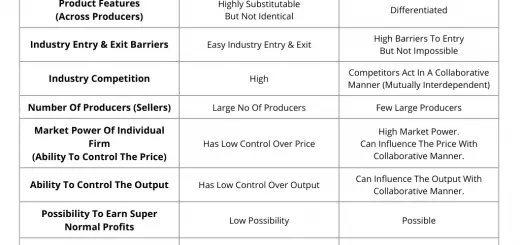Perfect Competition: Real Examples in USA, Canada, World
Perfect competition occurs when there are many sellers in the market who sells non-differentiated products. There are very low entry barriers and all firms are price takers. The firm will be unable to sustain itself in a perfectly competitive market if it tries to charge even a tiny amount more than the market price.
Following are the Real World Examples of Perfect Competition in the United States, Canada, Australia, and Other Countries.
Real World Examples of Perfect Competition in the United States, Canada, Australia, and Other Countries
1. Crops in the United States
Corn, wheat, soybeans, cotton, and hay are the major crops produced in the United States. These individual products are very similar. If we take wheat, it is a similar product produced by every American wheat farmer. As these products are non-differentiated, it is easy to buy land and start farming. This means low barriers to entry are there. But there is a high competition due to this. None of the farmers can be a price maker.
2. Pulp & Paper Manufacturing in Canada
The Paper Mills industry in Canada is a $6bn growing market. There are many companies in the industry including Cariboo, Kruger, Winpak, Supremex, and Hood Packaging. These manufacturers produce paper pulp and convert pulp into paper. These companies produce products like paper rolls and reams as the final output.
Since there are many producers in the industry which produce identical products, any firm can not raise and control the prices on their own. The pulp and paper production industry is an example of perfect competition.
3. Foreign Exchange Market in World
People exchange money from one currency to another using a foreign exchange shop. The product is non-differentiated (homogeneous) due to the same currency types applicable on every exchange (US Dollar, Great British Pound, Euro, Australian Dollar, etc..). There are many sellers and buyers in the market. One shop can not manipulate the exchange rate and earn supernormal profits due to the competition.
4. Sugarcane Production in Australia
Sugarcane production is a leading industry in Australia. Around 90% percent of sugar produced in Australia is grown in Queensland. Mackay, MSF, and Wilmar are some sugar-related companies available in Australia. The sugarcanes are used to produce juice, which is used to make sugar and many by-products.
Sugarcane is an identical product. Any farm area in Queensland produces the same sugarcanes. There is much competition in this industry since with the low entry barriers. The sugarcane production industry in Australia is an example of perfect competition.
5. Dairy Products in America
Dairy production is a major industry in America. American daily companies produce various products like fluid beverage milk, cheese, ice cream, yogurt, butter, and dry milk.
Products are identical where it is easily substitutable. There is a large number of dairy product producers available. Also, there are many competitors in the US dairy industry.
6. Barley Harvest in Canada
Around 23,000 farmers produce roughly eight million tonnes of barley annually (Reference: cafta.org). Canadian barley is primarily used as a food grain, natural sweetener, and an ingredient for brewing beer and making alcoholic beverages.
There are many producers in the barley production. Also, the product (barley) is non-differentiated. The barley industry can be classified as a competitive market.
7. Online Shopping (eCommerce)
Internet is home to many buyers and sellers nowadays. There are many eCommerce shops available in the world. The Internet allows customers to easily compare the products with the other sellers. Also, this results in much information on the customer’s end. Online shopping can be identified as an example of perfect competition.
Read More:
Market Structures
Perfect Competition
- Overview, Definition, & Features of Perfect Competition
- Main Characteristics / Causes of Perfect Competition
- Real Examples of Perfect Competition (in USA, Canada, Australia, World)
- Advantages and Disadvantages of Perfect Competition
Monopolistic Competition
- Overview, Definition, & Features of Monopolistic Competition
- Main Characteristics / Causes of Monopolistic Competition
- Real Examples of Monopolistic Competition (in USA, Canada, World)
- Advantages and Disadvantages of Monopolistic Competition
Oligopoly Market
- Real Examples of Oligopoly Market (in the USA, Canada, World)
- Seven Important Characteristics of Oligopoly Market
- Advantages and Disadvantages of Oligopoly Market
Monopoly Market
- Definition, Examples, and Characteristics of Monopoly Market
- Real Examples of Monopoly Market (in the USA, Canada, Australia, World)
- Important Characteristics / Causes of Monopoly Market
- Advantages and Disadvantages of Monopoly Market


